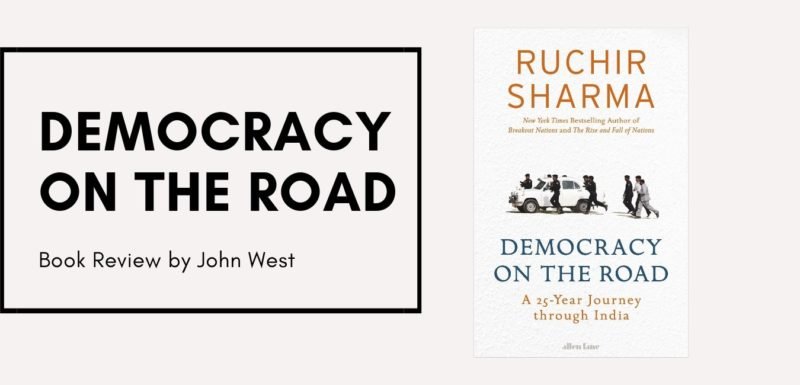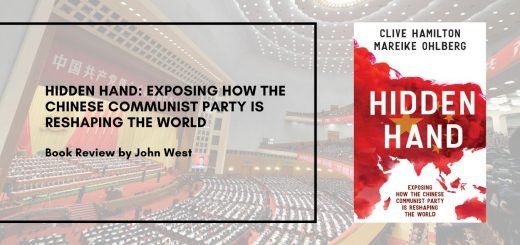Book Review: Democracy On The Road | John West

Ruchir Sharma’s recent book, Democracy On The Road, reports on a wonderful 25-year journey through 27 Indian elections, as John West reviews.
Sharma’s journey, along with a group of journalists and political analysts, opens a window on elections in virtually all of India’s 29 states, as well as national elections. Following the shock election loss of the Congress Party (under Rao) in 1996, Sharma realised that you have to get out on the road and see what is happening on the campaign trail. The group attends political rallies and meets with politicians from Sonia Gandhi and Narendra Modi down, as well as interacting with citizens on the ground to take the pulse of the electorate.
This is a fascinating book. India has long been celebrated as the world’s most populous democracy. It is ranked 41st out of 167 countries in the EIU’s Democracy Index. The only Asian economies that rank higher are — South Korea (21st), Japan (22nd), and Taiwan (32nd). It ranks well ahead of Malaysia (52nd) and the Philippines (53rd). But Sharma’s book takes us into the heartland of Indian democracy and provides greater richness and texture than indexes like that of the EIU could ever provide.
On the road with Sharma
Ruchir Sharma himself is Chief Global Strategist and Head of the Emerging Markets Equity team at Morgan Stanley Investment Management. He obviously has immense responsibility managing $20 billion in assets. But his favourite week of the year is returning home to India to go on the road to follow Indian elections.
He remarks that his book could well have been entitled “a Safe Passage of India”. His group never felt unsafe travelling into the interior of India, despite roads, traffic and hotels all too often being a nightmare. He cannot imagine doing such a trip to Brazil or South Africa because of the crime situation, the class warfare and how unsafe the rich feel outside their gated communities. Despite the talk about violence in India, the warmth and hospitality of the Indian people come through.
One of the merits of democracy is that the government is accountable to citizens for its performance. And so elections provide citizens with the opportunity “to throw the bums out” if the government’s performance is not up to scratch. But as Sharma writes, India suffers from an “anti-incumbency” phenomenon, whereby even if a government performs well, it usually loses elections. This also means that political leaders and parties frequently rotate in and out of government.
Winning Indian elections
According to Sharma, election results in India are dependent on several factors, with caste loyalty being the most important. Castes are still a reality of India and are as important as they have ever been. Other factors are religion, family connections, welfarism, money spending on the election, corruption and economic performance.
The connection between politics and economic performance is weak in India compared with many Western countries like the US. But the reality is that politicians rarely live up to their promises. They announce multiple programs. But they are rarely implemented because the state’s capacity to deliver is very weak. The state is broken in India, according to Sharma.
Further, major political parties are usually unable to win more than 30-35% of the vote in Indian elections. It is very difficult for one party to dominate in India with all its diversity. According to Sharma, this means that shifting alliances and coalitions play a big role in election outcomes.
Politics in India, especially at the national level, is all about welfarism, rather than policy reform. Socialism is part of the DNA of India’s political class. There is no constituency for free-market reforms in India. Big reforms at the national level will only ever be taken in response to the crisis, as in 1991.
China spent a lot on hard infrastructure — roads, bridges, railways, airports, energy supplies — which help economic growth, but didn’t spend much on the welfare state. India has done the reverse. At India’s current stage of its development, China spent 3 times on infrastructure what India does.
A story of many Indias
Indian politics and the economy are shaped by the reality that the country is more a collection of 29 separate states, rather than one integrated nation. In some states, the mainstream national political parties — Bharatiya Janata Party (“BJP”) and Indian National Congress (“Congress”) — have very little support or resonance.
South India is so different from the North. In Tamil Nadu, they don’t care about Prime Minister Modi or Rahul Gandhi. Politics are all about local stuff. The southern states don’t like too much Hindi being spoken. Only 40% of Indians nationwide speak Hindi. And Southerners are very sensitive to North Indian domination — all the more so given that south India is far more developed than the northern Hindi heartland. In India, nationalism has its limits, as sub-national identities are stronger.
Economic development and policy reform usually state phenomena, rather than national ones. Some state chief ministers have become more development focussed than what they used to be. They can get more done on the ground. But India could never be another China and achieve 10% economic growth rates because it does not have strong centralised power. India’s politics flow from its diverse society.
In short, Sharma’s book is a story of many Indias, not a monolithic India. India is more of a continent than a country. India is a country of 29 nations. To have a national narrative is very difficult. In Delhi, it is very common to think of India in national terms. But most voters don’t think that way. They think locally, about their own local concerns.
Despite these reservations, India does have some strong points, notably its companies. If you define good companies as those with a market cap of $1 billion or more, and that can regularly return earnings growth of 15%, India has the world’s highest number of good companies.
One important trend in recent decades has been the rise of single (unmarried) political leaders like Prime Minister Modi. Today, one-third of state Chief Ministers are single, whereas there were none in the 1980s. They can argue that they are on their own, they are not beholden to a family or dynasty. They are less prone to corruption and more committed. Indian political life is so demanding that it is impossible to have a private life, despite the cultural importance of marriage and family in India.
Another trend is the rise of the woman voter and the decline of family voting whereby the whole family votes in the same way as the male head.
Modi mania in 2014 and 2019
The national election of 2014 witnessed a rare event when a single party, the BJP, won a majority of seats in the lower house of the parliament — even though it only won 31% of the national vote. The opposition was so badly divided and fragmented.
In 2014, Narendra Modi’s BJP rode a wave of hope. He seemed like a great reformer. Modi announced that his priority was minimum government and maximum governance. Sharma wrote that this was India’s “Ronald Reagan moment”. He hoped that India might finally achieve “economic freedom” more than half a century after it achieved its political freedom.
But hopes and expectations haven’t been met. It is still very difficult to do business in India. Two-thirds of banking is in the public sector. For Modi, it has proved much harder to govern the nation than the state of Gujarat where he was previously Chief Minister. Modi should have done more to bring people together.
For all Sharma’s knowledge of India’s elections and politics, was he able to predict the result of the 2019 national elections? No! (Sharma’s book was published before the election.)
Early on, Sharma predicted that it would be a 50/50 election, with alliances determining the final result. Closer to the election he believed that Modi would win, but fall short of a majority of seats, and would need allies to govern.
But what we saw was a “wave election”, with a swing of 6-7% to Modi’s BJP. This swing was driven by new youth voters coming of age. They upended many of the rules of Indian politics by not voting along caste lines and not voting anti-incumbency.
Young people are thinking of elections in more presidential terms. They seem to have voted for Modi, and more than the BJP. Young voters see Modi as more hard-working and dedicated than Rahul Gandhi. India needs a strong leader because of its problems with Pakistan.
Congress’s Rahul Gandhi was obliterated by the Modi machine. Sharma does not see any challenger to Modi in coming years. Rahul Gandhi can’t compete. The opposition needs to find the right candidate to stand up to Modi.
99% of people on the ground did not detect this wave. Sharma has “never been this surprised” by an election result.
Despite his big mandate, Modi is facing a more difficult environment, as India is now being hit by the slowdown in the global economy. Modi needs to accelerate reform by devolving more power to the states says Sharma.
India’s thriving democracy?
Sharma concludes that in contrast to many other countries, democracy is thriving in India, as evidenced by its very competitive elections and the maturity with which the opposition handled defeat. Nevertheless, international interest in Indian elections and in India itself is very low, and the international media has turned on Modi.
Not everyone would agree with Sharma’s positive assessment of India’s democracy, notably Ramachandra Guha, a historian of modern India and biographer of Mahatma Gandhi. Ramachandra Guha recently wrote “I would downgrade my country’s democratic credentials. Given the lack of any sort of credible opposition to the BJP, the atmosphere of fear among religious minorities and the attacks on a free press, we are now a 40-60 democracy, and — if the recent abuse of state power in Kashmir is any indication — well on the way to becoming 30-70.”
This Book Review first appeared in the Asian Century Institute – One of The Kootneeti’s Knowledge Partners
REFERENCES:
– Ruchir Sharma. Democracy on the Road: A 25 Year Journey through India
– Economist Intelligence Unit. Democracy Index 2018
– Ramachandra Guha, India was a miracle democracy. But it’s time to downgrade its credentials. Washington Post, August 14, 2019.



















